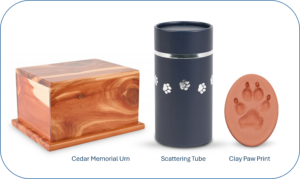End of Life Decisions
As our pets age or develop serious disease, we become faced with the obligation to make the best, most compassionate decisions on their behalf. Please retain this information for your reference and call us as needed.
Quality of Life/When is it “time”?”
Assessing quality of life factors can help you to decide when the most loving thing that you can do is help your beloved pet pass away peacefully. There are a few key indicators to consider:
- Does your pet still engage in activities that s/he used to love?
- Does your pet respond to affection in the usual way?
- Does the pain or suffering outweigh the enjoyment in life?
- Can we improve your pet’s condition or is it terminal?
- Does your family agree on the answers to the above questions?
|
Quality of Life Scale Answer each question with a number 1-10, 10 being great/normal |
|
| Score | Criterion |
| Hurt: Is your pet’s pain successfully managed? Does your pet need oxygen therapy? | |
| Hunger: Is your pet eating enough? Does hand feeding help? | |
| Hydration: Is your pet dehydrated? Does your pet need subcutaneous fluid daily? | |
| Hygiene: Are you able to keep your pet clean and brushed? | |
| Happiness: Does your pet express joy or interest regarding family, toys, etc.? Is your pet depressed, anxious, bored, or afraid? | |
| Mobility: Can your pet get up without assistance? Does your pet want to do normal activity (go for a walk)? Is your pet having seizures or stumbling? | |
| More good days than bad: When bad days outnumber good days, quality of life might be compromised. | |
| Total: A total greater than 35 can represent an acceptable quality of life | |
Adaptation from Villalobos, A.E, Quality of Life Scale Helps Make Final Call
It can be difficult to assess your pet’s behavior on a day-to-day basis. We recommend keeping a journal so you can evaluate your pet’s good and poor days over a period of time.
Counseling Resources
- Animal Emergency & Referral Center of MN Pet Loss Support Group: (651) 501-3759, ext. 3005
- University of Minnesota Veterinary Social Services: 612-624-4747
- Pet Loss Support Hotlines: 800-565-1526, 888-332-7738, 877-394-2273
- Chat Groups on www.aplb.org
Websites
Books for Adults
- Final Farewell: Preparing for and Mourning the Loss of Your Pet By Marty Tousley and Katherine Heuerman
- Healing the Pain of Pet Loss: Letters in Memorium edited by Kymberly Smith, The Charles Press.
- Absent Friend: Coping with the Loss of a Treasured Friend by Laura and Martyn Lee
Books for Children
- For Every dog an Angel by Christine Davis
- For Every cat an Angel by Christine Davis
- I’ll Always Love You by Hans Wilhelm
What is Euthanasia?
Euthanasia is the act of helping your pet pass away painlessly. This is achieved by a Veterinarian injecting an overdose of an anesthetic agent into your pet’s vein. Your pet becomes unconscious and the heart stops. This procedure is very quick and the patient may pass away before all of the injection has been given.
We recommend placing a catheter in the vein before giving the injection so that the procedure may go more smoothly. We place a catheter at no extra cost and while it may take some additional time to perform the procedure, it allows us to administer the euthanasia solution without restraint or a needle poke in front of you. Some patients or guardians also feel more comfortable if the pet is first given a sedative injection.
Who should be present?
Not everyone is comfortable witnessing a beloved pet die. There is no shame in this. However, if you are comfortable staying with your pet, then we welcome you to do so.
It may be helpful to understand what death looks like before you decide what is best for you. In most cases of euthanasia, the pet quickly becomes limp and stops breathing. Animals do not close their eyes when they die. Rarely, there may be what appears to be a breath or some muscle twitches. These are purely reflexes and not a conscious activity of the pet. In some cases, pets that are very dehydrated and weak may have weak veins as well. In these cases, we may have to use more than one vein to administer the euthanasia solution or have difficulty placing a catheter.
Care of Remains
Cremation is the most common way that we take care of your pet’s remains. If you wish to have your pet’s ashes returned to you, we rely on Pets Remembered Cremation Service for private and compassionate care of your pet’s remains. Pets Remembered cremates each pet individually. You will receive your pet’s ashes in your choice of a cedar urn or scattering tube. Ashes are typically ready to pick up at our clinic within 3-4 business days. You will also receive one ink paw print, one imprint of your pet’s paw in clay, and a fur clipping. Pets Remembered can discuss other urn options for an additional fee.

If if you have a pet cemetery plot, then you are more than welcome to take your pet with you.
Keepsakes
Hot Paws offers glass impressions of your pet’s paw print. At this time we do not offer the kit in our clinic. If you wish to purchase the DIY kit from them directly we are happy to assist you in getting the best print to send in. For more information, visit their website: http://www.hotsandap.com/hot-paws
Petsies Stuffed Animals makes personalized stuffed animals, pillows, and more of your pet: https://www.mypetsies.com
|
Same Day Cremation
Alternative ideas for remains · Cremation Jewelry |
At Home Euthanasia Options · MN Pets |
How will my appointment go?
Many clients prefer more privacy when coming in for this appointment. Please call us when you arrive at the Clinic and we can direct you to your room through the back door entrance. We will need the owner on the account to fill out some paperwork with your cremation choice. At this time, many clients choose to pay for the procedure so you can leave at any time afterwards. After your pet has its catheter placed, you will let us know when you are ready for the Veterinarian to come in and administer the euthanasia solution.
Please let us know if you have any questions or concerns before your appointment.
Contact Us

